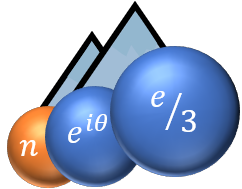The effect of Coulomb blockade in a single-electron transistor (SET), a device where Fermi-liquid leads are mediated by a quantum dot, plays an essential role in condensed matter physics, mesoscopics and open quantum systems [1]. The Coulomb spectroscopy and transport through a quantum dot are sensitive to the precise nature of the nonequilibrium steady state, the mechanisms of relaxation, electronic interactions and topological order. The “orthodox” theory of Coulomb blockade is based on rate equations formulated in the basis of different charged states in the island. Such states are well defined for almost isolated quantum dots which have weak tunnel coupling to the leads, i.e, with a small dimensionless conductance when the Coulomb blockade is weak and the charge is ill defined, the description via the dissipative Ambegaokar-Eckern-Schön (AES) action for the phase becomes more convenient. In equilibrium, the saddle points of the Matsubara AES action are known as Korshunov instantons. These instantons allow one to take into account charge discreteness and obtain the residual, exponentially small gate charge oscillations of the conductance. If the relaxation is weak then the distribution function in the island is a non-Fermi one at finite voltages. It causes a nonequilibrium steady state that can not be captured by the “orthodox” theory or the imaginary time technique, and consequently the real-time Keldysh formalism is required [2,3].
In this talk, we discuss our recent results [4] on charge transport in a SET implemented as an interferometer such that the Coulomb blockaded middle island contains a circular chiral Majorana or Dirac edge mode. The devices under consideration can be implemented in hybrid structures with superconductors, topological insulators or quantum anomalous Hall insulators. We concentrate on the regime of small conductance. At low voltages one thus expects a strong suppression of the charge transport. At higher voltages, which exceed significantly the charging energy of an island, the almost Ohmic behavior is accompanied by the offset (deficit) current and residual gate charge oscillations. Here, we were able to describe this high voltage regime asymptotically exact. Instead of using the kinetic equations, which is challenging due to a large number of relevant charge states, we employ a path integral technique and succeed solving the problem by finding a dominant path, an alternative kind of instanton, for the phase variable.
The distinctions between Majorana and Dirac cases appear when the tunnel junctions are unequal. The main difference is in the offset current at high voltages which can be higher up to 50% in the Majorana case. It is caused by an additional particle-hole symmetry of the distribution function of Majorana fermions. There is also an eye-catching distinction between the oscillations patterns of the current as a function of the gate charge. We conjecture this distinction survives at lower transport voltages as well.
[1] L. P. Kouwenhoven, G. Schön, and L. L. Sohn, “Introduction to mesoscopic electron transport,” in Mesoscopic Electron Transport, (Springer Netherlands, 1997) pp. 1-44.
[2] A. Altland and R. Egger, “Nonequilibrium dephasing in Coulomb blockaded quantum dots,” Phys. Rev. Lett. 102, 026805 (2009).
[3] M. Titov and D. B. Gutman, “Korshunov instantons out of equilibrium,” Phys. Rev. B 93, 155428 (2016).
[4] D. S. Shapiro, A. D. Mirlin, and A. Shnirman, Phys. Rev. B 107, 125404 (2023).

 PDF version
PDF version
